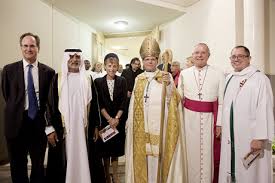
I have just received by email a very nice brochure from the Canadian Council of Churches entitled, Hope, Gratitude, and Solidarity: a Message from Religious Leaders in Canada in Response to the Covid-19 Pandemic. It is well-produced, with a lovely yellow flower adorning the cover and lovely photos within of a sun-drenched field, a young family of four, a doctor in a surgical mask, an elderly woman looking at her relative through an I-pad, and a young woman raising her arms in the sun. And, on the back cover, another picture of the yellow flower. It offers a positive message, and wise counsel—namely that we should all be grateful and appreciative of the doctors and other health professionals caring for us on the front lines; that we should all follow the directions of those health professionals and our politicians; and that we all need to pull together. It specifically singles out the plight of the First Nations, Metis, and Inuit, as well as refugees and migrant workers. It urges us all to prayer, and even mentions God three times, calling Him “the Creator”, “God”, and “the loving and ever merciful God, the source of all hope”.
I found it a very positive document. It was signed by representatives of all the various Christian churches, including the Mormons, and by leaders from Jewish, Muslim, and Buddhist communities. The accompanying letter introducing the brochure says that it “has received over 80 signatories from ecumenical and interfaith communities across Canada”, which is “certainly an achievement worth celebrating!”
One can hardly fault anything in the encouraging and innocuous brochure, or the signatories who signed it, since to refuse one’s signature might be taken as dissent from the positive message it contains, and what follows does not constitute a denunciation of those who signed it or its much-needed message. But for me the main value of the document was that it served to reveal and emphasize the true role and function of religious leaders—a function which was not fulfilled by the production of the brochure.
Specifically, it is the function of religious leaders to share with the world revealed truth that is not available anywhere else. What exactly that truth is, of course, depends entirely upon the individual religious leader sharing it. A Muslim religious leader, for example, might say that all things come from the hand of Allah, who will one day raise all from the dead and judge them, rewarding with the consolations of paradise those who have pleased Him by their Islamic faith and good deeds. A Buddhist religious leader might say that all suffering comes from our commitment to illusion, and that eventually all who have followed the Noble Eightfold Path will return to the bliss of undifferentiated unity and Nirvana where there is no more suffering. A Christian religious leader would say that Christ’s death on the cross and His resurrection from the dead have opened the Kingdom of heaven now for all who repent and receive baptism, so that on the Last Day they will receive a weight of glory beyond all comparison.
One notes that the defining messages of all these different religious leaders are very different, and in fact are incompatible with one another. Each message is worth hearing, for each message contains something that cannot be found elsewhere in the world apart from their respective religions—which is why they are worth hearing. But all the messages cannot be equally true, for the visions of truth and reality they proclaim differ greatly from each other.
One can hardly blame the leaders who signed the document and produced the brochure, for if an individual religious leader is constrained to share only what all the other leaders can also accept, the resultant message will differ dramatically from what it would be if he could fully share his faith. In this case, the watered-down message will hardly differ at all from the message already shared by health professionals and politicians.
That is the problem with ecumenical inter-faith messages—they are heartbreakingly obvious and pathetically general. We don’t need input from religious leaders to know that motherhood is sweet and the sky a lovely blue colour. We need them to tell us things we could not discover on our own.
In other words, we hardly need our religious leaders to tell us that we should be grateful to doctors and nurses, that we should follow government directions, and all pull together. Every day our health professionals and government leaders tell us exactly that over and over again. It is good advice, but it is hardly a revelation that requires religious leaders to share it.
There is, I repeat, nothing wrong with repeating the obvious. But a Christian religious leader will also share with the world things that are less obvious—such as the fact that the risen Son of God offers a joy and a hope only found in Him. Whether that message will be as welcomed by the secular media as the one recently produced by the Canadian Council of Churches is another question. But that remains his task and function nevertheless.
We turn to religion not to find advice that everyone already knows and that governments ceaselessly repeat. We turn to religion to find hidden truth that only comes through supernatural revelation and to find comfort and hope that comes only that has risen from the dead. Religious leaders such as clergy serve no other function than to transmit these hidden truths and bring trembling souls to this immortal hope. That is what they are really good for.
